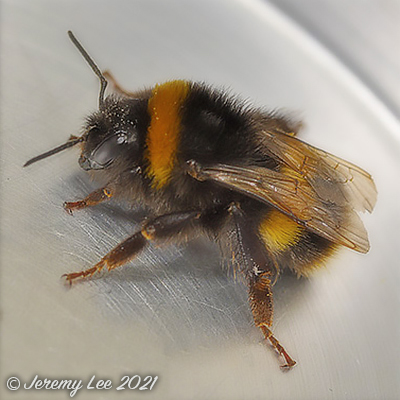
 |
|
Scientific Classifications explained » Amphibians » Ants » Aphids » Bees » Beetles » Birds » Bugs » Butterflies » Caterpillars » Damselflies » Dragonflies » Earwigs » Flies » Frog/Leafhoppers » Fungi » Galls » Grasshoppers » Harvestmen » Hoverflies » Lacewings » Ladybirds » Leaf Mines » Lichens » Mammals » Millipedes » Mosses » Moths » Sawflies » Slugs » Snails » Spiders » Trees » Wasps » Wild Flowers » Woodlice |
UK Nature > Bees > Bombus terrestris

Scientific Name: Bombus terrestris Common Name: Buff-tailed Bumblebee Bombus terrestris, or the Buff-tailed Bumblebee as it's more commonly known, is usually up to 25mm in length; the collar (front of thorax) and 2nd abdominal segment orange or golden yellow, usually much darker than in the White-tailed Bumblebee (Bombus lucorum). The queen has the tip of her abdomen buff or gingery in the UK, but white on the continent. Workers usually have a white tip, often tinged with brown towards the front. Visits a wide range of flowers, including apple and cherry blossom. Queens are frequent visitors to sallow catkins in March and April. Nests are built below ground level. To be found in almost any well-vegetated habit. Widespread across the UK except northern Scotland. |
|

https://www.uknature.co.uk is a website dedicated to showing the immense diversity of UK nature and wildlife. Our vast range of habitats, from lowland arable to snow covered mountains, from storm-ravaged coastlines to peaceful inland freshwater lakes and rivers, from dry, sandy heaths to deciduous and coniferous forests, all these habitats contribute to the abundance of UK nature. We have wild birds in huge numbers either residing or visiting our shores (597 recorded species as at July 2013) and we must also not forget the humble back garden with its grass lawns, flower beds filled with nectar rich flowers, shrubs and trees, all designed to attract huge numbers of insects such as bees, moths, butterflies and hoverflies; and finally the small ponds which provide safe havens for frogs, toads, newts and even slow worms and grass snakes. www.uknature.co.uk is the showcase for my personal passion, photographing uknature in all its glory. I sincerely hope you all enjoy the fruits of my labours. This site and all images contained therein is © Jeremy Lee 2004 - 2021. All Rights Reserved. Site design by Jeremy Lee. Site development & IT Support by Stuart Lee. |